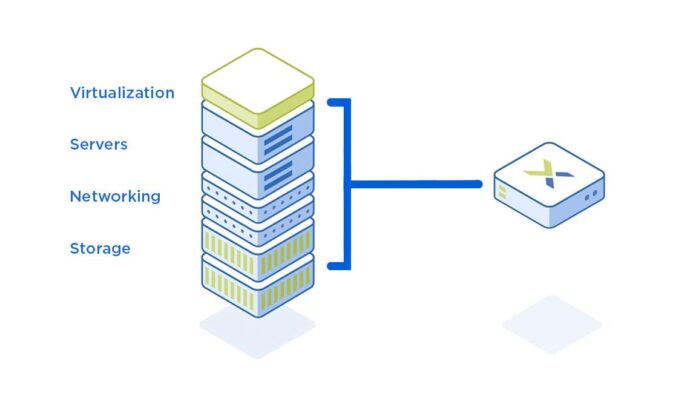Chapter 1 explores the existing data network designs and their challenges. It also discusses the evolution of host hardware, such as enhanced central processing units (CPUs), high-speed server-to-storage interconnects, and the emergence of flash-based products.
Then, this book dives into the software-defined storage (SDS) trend that decouples storage functionality from hardware arrays. This is where established software vendors and new entrants have been significantly impacted.
What Is Hyperconvergence?
While the exact origins of hyperconvergence are unknown, they can be traced back to web-scale companies that developed their infrastructure to support data centers that served up millions of daily requests and queries. What is hyperconverged storage? Hyperconverged storage offers a compelling proposition for businesses seeking to simplify their IT infrastructure, improve performance and scalability, and optimize their data management. The engineers realized that the technologies they built could be leveraged to solve enterprise IT problems like reducing complexity, eliminating hardware and storage bottlenecks, and lowering operational costs while raising performance.
The first step was to consolidate traditional data center hardware into a single system using converged infrastructure solutions to achieve this goal. Vendors bundle servers, networking, and storage into a physical appliance with software that was pre-tested to avoid incompatibility issues. While this approach made it easier for IT teams to deploy and manage, it exposed the underlying architecture to hardware changes and limitations as upgrades and updates were required.
The next step was to make converged infrastructure scalable, flexible, and agile by moving away from the proprietary hardware and adopting a Software-Defined Everything approach. Hyperconverged systems use industry-standard x86 hardware and software to virtualize the operating functions of the system so that they can be shared across the cluster. Storage is controlled at the OS or hypervisor level with a virtual storage controller that runs on each server in the cluster, eliminating the need for dedicated hardware and reducing cost.
What Are the Benefits of Hyperconvergence?
There are a variety of benefits that hyper-convergence brings to the table, both as an alternative to traditional hardware architectures and cloud solutions. According to the 2020 Spiceworks State of IT report, these include reducing costs, increasing operational efficiency, increasing energy efficiency, and simplifying IT and systems management.
Hyperconverged storage solutions replace separate servers, networks, and hardware arrays, significantly reducing the data center footprint. It provides agility for your business to scale as needed. Hyperconverged infrastructure also simplifies the work of system administrators, allowing them to manage and monitor all IT components from a single pane of glass.
In addition, hyper-converged systems eliminate the need for dedicated hardware and software for each function, making it possible to streamline your IT infrastructure. It allows your company to reduce operating costs, save space, and free up staff resources for other projects.
With the advent of disaggregated HCI, some vendors offer a hybrid model that supports both integrated and disaggregated hardware design, allowing you to choose between the two approaches. Essentially, disaggregated hardware models allow you to separate CPUs and memory from storage, and the different resource modules can then be connected across a network. It can sometimes be more efficient, though it may impact performance. Additionally, it can still be more complicated to manage and upgrade.
What Are the Challenges of Hyperconvergence?
For IT leaders, hyper-convergence offers several key benefits. These include simpler operations, a smaller data center footprint, and improved performance that delivers more significant infrastructure ROI. However, it’s essential to carefully evaluate the technology and perform proof-of-concept testing before implementing it.
HCI solutions use commodity hardware components to simplify the management of computing, storage, and virtualization resources. They can also offer higher performance than traditional converged systems, integrating multiple vendors’ products and hardware.
But these benefits come with some challenges, as well. HCI can be difficult to deploy and manage, especially compared to traditional systems built using custom, integrated hardware. These solutions also tend to have a high price tag, which can be challenging for IT organizations.
Another challenge of hyper-converged systems is their need for redundancy. While many HCI vendors promote their solutions as scalable, they often need to lend themselves to granularly scaling individual resources. For example, if an enterprise needs more storage in its environment, it must add a node that contains not only additional storage but also extra memory and computing capacity.
Finally, it is critical to choose an HCI solution compatible with existing IT tools and processes. Ideally, these solutions should allow users to monitor and control their system through the same interface they’re used to working with.
What Are the Solutions for Hyperconvergence?
Hyperconverged systems combine storage, computing, and virtualization technologies in a single hardware unit. They can be pre-integrated into an appliance or delivered as software for deployment on existing servers.
The benefits of HCI are clear: They can be deployed quickly, scale rapidly, and provide a consistent IT experience across the organization. They can also reduce IT infrastructure costs, improve energy efficiency, and simplify IT operations.
Initially, hyper-converged solutions targeted VDI and other workloads with predictable resource requirements. However, they have evolved into scalable platforms for general enterprise applications and databases.
With the growth of cloud adoption, many organizations want to migrate their data centers to converged infrastructure. HCI solutions are an excellent option as they can be deployed on standard x86 hardware and installed on existing hardware, making them an affordable alternative to traditional three-tier infrastructure.
Read Also: Exploring the Role of a NetSuite Partner in Business Operations
HCI vendors use a Software-Defined Everything approach to create converged infrastructure solutions that offer increased flexibility and cost savings. These solutions use industry-standard x86 servers and the virtualization layer of the operating system or hypervisor to converge computing, storage, and management functions into a single building block with unified management.



